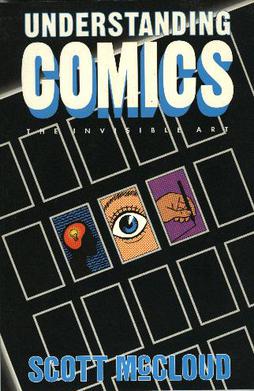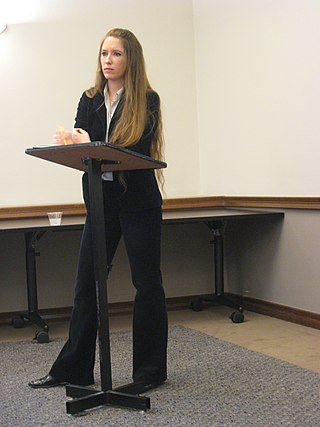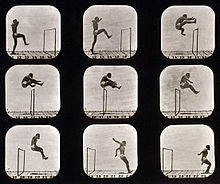
William Erwin Eisner was an American cartoonist, writer, and entrepreneur. He was one of the earliest cartoonists to work in the American comic book industry, and his series The Spirit (1940–1952) was noted for its experiments in content and form. In 1978, he popularized the term "graphic novel" with the publication of his book A Contract with God. He was an early contributor to formal comics studies with his book Comics and Sequential Art (1985). The Eisner Award was named in his honor and is given to recognize achievements each year in the comics medium; he was one of the three inaugural inductees to the Will Eisner Comic Book Hall of Fame.
A graphic novel is a long-form work of sequential art. The term graphic novel is often applied broadly, including fiction, non-fiction, and anthologized work, though this practice is highly contested by comics scholars and industry professionals. It is, at least in the United States, typically distinct from the term comic book, which is generally used for comics periodicals and trade paperbacks.

Comics is a medium used to express ideas with images, often combined with text or other visual information. It typically takes the form of a sequence of panels of images. Textual devices such as speech balloons, captions, and onomatopoeia can indicate dialogue, narration, sound effects, or other information. There is no consensus among theorists and historians on a definition of comics; some emphasize the combination of images and text, some sequentiality or other image relations, and others historical aspects such as mass reproduction or the use of recurring characters. Cartooning and other forms of illustration are the most common image-making means in comics; Photo comics is a form that uses photographic images. Common forms include comic strips, editorial and gag cartoons, and comic books. Since the late 20th century, bound volumes such as graphic novels, comic albums, and tankōbon have become increasingly common, along with webcomics as well as scientific/medical comics.

Scott McCloud is an American cartoonist and comics theorist. He is best known for his non-fiction books about comics: Understanding Comics (1993), Reinventing Comics (2000), and Making Comics (2006), all of which also use the medium of comics.

Understanding Comics: The Invisible Art is a 1993 non-fiction work of comics by American cartoonist Scott McCloud. It explores formal aspects of comics, the historical development of the medium, its fundamental vocabulary, and various ways in which these elements have been used. It expounds theoretical ideas about comics as an art form and medium of communication, and is itself written in comic book form.

Maus, often published as Maus: A Survivor's Tale, is a graphic novel by American cartoonist Art Spiegelman, serialized from 1980 to 1991. It depicts Spiegelman interviewing his father about his experiences as a Polish Jew and Holocaust survivor. The work employs postmodern techniques, and represents Jews as mice and other Germans and Poles as cats and pigs respectively. Critics have classified Maus as memoir, biography, history, fiction, autobiography, or a mix of genres. In 1992 it became the first graphic novel to win a Pulitzer Prize.

Comics and Sequential Art is a book by American cartoonist Will Eisner that analyzes the comics medium, published in 1985 and revised in 1990. It is based on a series of essays that appeared in The Spirit magazine, themselves based on Eisner's experience teaching a course on comics at the School of Visual Arts. It is not presented as a teaching guide, however, but as a series of demonstrations of principles and methods. A 1990 expanded edition of the book includes short sections on the print process and the use of computers in comics. Eisner followed with a companion volume, Graphic Storytelling and Visual Narrative, in 1996.

A Contract with God and Other Tenement Stories is a graphic novel by American cartoonist Will Eisner published in 1978. The book's short story cycle revolves around poor Jewish characters who live in a tenement in New York City. Eisner produced two sequels set in the same tenement: A Life Force in 1988, and Dropsie Avenue in 1995. Though the term "graphic novel" did not originate with Eisner, the book is credited with popularizing its use.

Making Comics: Storytelling Secrets of Comics, Manga, and Graphic Novels is a book by comic book writer and artist Scott McCloud, published by William Morrow Paperbacks in 2006. A study of methods of constructing comics, it is a thematic sequel to McCloud's critically acclaimed books Understanding Comics and Reinventing Comics.
The use of comics in education is based on the concept of creating engagement and motivation for students.

Graphic Storytelling and Visual Narrative is a 1996 book by American cartoonist Will Eisner that provides a formal overview of comics. It is a companion to his earlier book Comics and Sequential Art (1985).
The history of comics has followed different paths in different parts of the world. It can be traced back to early precursors such as Trajan's Column, in Rome, Egyptian hieroglyphs and the Bayeux Tapestry.
Comics studies is an academic field that focuses on comics and sequential art. Although comics and graphic novels have been generally dismissed as less relevant pop culture texts, scholars in fields such as semiotics, aesthetics, sociology, composition studies and cultural studies are now re-considering comics and graphic novels as complex texts deserving of serious scholarly study.

Breakdowns is a collected volume of underground comic strips by American cartoonist Art Spiegelman. The book is made up of strips dating to before Spiegelman started planning his graphic novel Maus, but includes the strip "Maus" which presaged the graphic novel, and "Prisoner on the Hell Planet" which is reproduced in Maus. The original edition of 1977 is subtitled From Maus to Now; the expanded 2008 edition is subtitled Portrait of the Artist as a Young %@&*!.
Graphic medicine connotes the use of comics in medical education and patient care.
Comics has developed specialized terminology. Several attempts have been made to formalize and define the terminology of comics by authors such as Will Eisner, Scott McCloud, R. C. Harvey and Dylan Horrocks. Much of the terminology in English is under dispute, so this page will list and describe the most common terms used in comics.
Neil Cohn is an American cognitive scientist and comics theorist. His research focuses on the cognition of understanding comics, and uses an interdisciplinary approach combining aspects of theoretical and corpus linguistics with cognitive psychology and cognitive neuroscience.

Hillary Chute is an American literary scholar and an expert on comics and graphic narratives. She is Distinguished Professor of English and Art + Design at Northeastern University. She was formerly associate professor in the Department of English at the University of Chicago and an associate faculty member of the University’s Department of Visual Arts, as well as a visiting professor at Harvard University. She was a Junior Fellow at the Harvard Society of Fellows from 2007 to 2010.

Sequart Organization is an online magazine that focuses on the study of popular culture and the promotion of comic books as an art form. Sequart also publishes books and produces documentary films. It was founded in 1996 by Julian Darius. Sequart's editor-in-chief is Mike Phillips.

The hybrid novel is a form of fiction, characterized by reaching beyond the limits of the anticipated medium through the incorporation of varying storytelling methods, such as poetry, photography, collage, maps, diagrams, posters and illustrations. The hybrid novel refers to a broad spectrum of literary work such as the graphic narrative and fusion texts.














